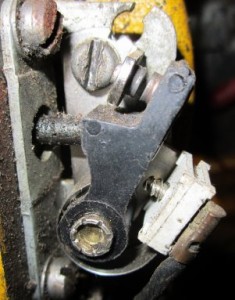Let’s attack what I consider the easiest problem to solve first; an electrical one with no spark. The operation of a single cylinder engine is pretty simple. As the piston travels downward, it sucks air and gas from the carburetor into the cylinder. As the piston travels upward, it compresses the air gas mixture. The spark plug ignites the mixture causing an explosion that forces the piston back downward. (I know. I know. It requires valves opening and closing and proper timing, but I’m trying to keep this explanation as simple as possible. I’ll write an article later on more advanced stuff – like timing.)
The first thing I do if I have an electrical problem is to check at the spark plug. I’ve tried using those “spark plug checkers”, but I’ve had the best luck by removing the spark plug. After the spark plug is removed, ground it against the block and crank over the engine. Again, be careful. We’re dealing with a high voltage. It won’t kill you but it will sure hurt like the dickens. I lay the spark plug on the engine; I don’t even hold it by the spark plug wire. What you check next depends upon what you observe:
This is what I always hope for with an electrical problem. It’s the easiest to debug. If I don’t have a spark, the first thing I try is a new spark plug. If that doesn’t cure the problem (usually doesn’t) it’s going to require the use of a voltmeter. (There will be a discussion on voltmeters in another article (when I get time) if you don’t own one or have never used one.) Set your voltmeter to read DC volts. With the key off, connect the positive lead of the voltmeter to the + (positive) terminal of the coil and connect the negative lead to a good ground. (A pair of jumper wires is a big help in any electrical debugging.)
When you turn the key on, you should have +12 volts reading on the meter. If you don’t have +12 volts here, you could have a variety of problems that could be as simple as not pushing down the clutch to engage the safety switch—you’re not getting 12 volts from the battery to the coil. (I have eliminated the safety switch on all my Cub Cadets.) Again, this problem is discussed in another article.
For now, let’s assume you have the +12 volts on the plus side of the coil. Move the positive lead to the – (minus) side of the coil. With the key on, rotate the engine over slowly by hand. (If you still have the spark plug removed, the engine should rotate relatively easy.) When the points are open, you should have a +12 volt reading on the voltmeter. When the points close, the reading should drop to zero. Briefly what happens is this: With the points closed, the coil is grounded and current flows through the coil creating a magnetic field. When the points open the current stops flowing causing the magnetic field set up in the primary side of the coil to collapse creating a large voltage in the secondary windings. This large voltage causes an arc to jump across the end of the spark plug which ignites the fuel.
On the majority of starting problems I’ve worked on, this reading remains at +12 volts. That means the points aren’t grounding the negative side of the coil. This could be a result of the points not completely closely, but generally it’s a result of poor conductivity across the points.
The picture on the left shows the location of the points with the point cover removed. The picture on the right shows a closeup of the points with the points open. (This point gap is too wide, but illustrates the point.) With the points open, place a piece of paper (notebook paper or a dollar bill works best) in the gap and rotate the engine until the points close. Pull the paper out and repeat the process several times. Sometimes you can see the carbon film thats removed on the paper. This process is especially important when you install a new set of points.
Don’t file the points. Just drag a piece of paper through the closed points until you get continuity; i.e., the voltage drops to zero when the points are closed. When the points are operating properly you should be able to use your finger to flip the points open and create a spark at the spark plug (with the key on). (It’s only 12 volts across the points so you won’t get shocked.)



